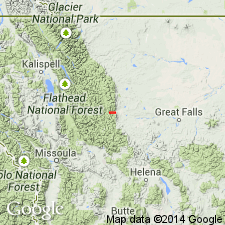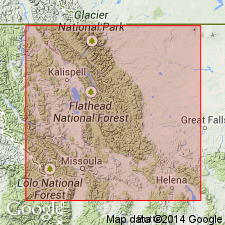
- Usage in publication:
-
- Castle Reef Dolomite*
- Modifications:
-
- Named
- Dominant lithology:
-
- Dolomite
- AAPG geologic province:
-
- Sweetgrass arch
- Montana folded belt
Summary:
Upper formation of Madison Group in Sun River Canyon area, Sweetgrass arch and Montana folded belt province. Named for Castle Reef for exposures north of Diversion Lake in ridge that forms east side of Hannan Gulch, T22N, R10W, Patricks Basin quad, Teton CO, MT. These exposures designated the type locality. Overlies Allan Mountain Limestone (new), lower formation of Madison in Sun River Canyon. Is of Osage and Meramec, or Early and Late Mississippian age. Divided into a lower member which consists of dolomite, gray, tan-gray, and brown-gray, dense, fine, medium, to coarsely crystalline dolomite limestone that is often dolomitic, gray-brown to tan-gray, occasionally dense, very fine grained to fine, medium, to coarsely crystalline; and an upper member, the Sun River Member, which is a medium- to very light gray, medium- to coarsely crystalline dolomite, fine and medium at base, crystalline in upper part. Lower member is 375-475 ft thick; Sun River is 250-330 ft thick. Underlies Jurassic Ellis Group unconformably. Is fossiliferous: mostly corals and brachiopods. Approximately same age as Mission Canyon Limestone, or Early and Late Mississippian.
Source: GNU records (USGS DDS-6; Denver GNULEX).

- Usage in publication:
-
- Castle Reef Formation*
- Modifications:
-
- Principal reference
- Revised
- Redescribed
- AAPG geologic province:
-
- Sweetgrass arch
- Montana folded belt
Summary:
Redescribed--name changed from Castle Reef Dolomite to Castle Reef Formation in the Sawtooth Range which lies in both Sweetgrass arch and in Montana folded belt province. Divided into: 1) Gateway Pass unit (at base), a 50-m-thick, massive white dolomitized grainstone, characterized by large-scale tabular cross-bedding and having inter-bedded, dolomitized mudstone and wackestone (previously called lower member and Sun River Member of Castle Reef); and 2) Dupuyer Creek unit (at top), a 30-75-m-thick, gray, thin- to thick-bedded dolomitized lime mudstone, skeletal packstone, and wackestone with occasional chert nodules. Has coral, bryozoan, and brachiopod fossils. Name Sun River Member not used because that name was applied to all secondarily dolomitized rocks of the upper part of Madison Group. Lower contact of Castle Reef raised 116 m. Conformably overlies upper member, (upper contact revised) of Allan Mountain Formation throughout Sawtooth Range. Change in placement of lower contact of Castle Reef coincides with an abrupt regional change in sedimentation from a low-energy environment (Allan Mountain) to high-energy (Castle Reef). Is unconformably overlain by Jurassic Ellis Group. Principal reference section designated at North Fork of Dupuyer Creek in NW1/4 NW1/4 SW1/4 sec 21, T27N, R9W, Walling Reef quad. Varies in thickness from 100-145 m. Is of Mississippian age.
Source: GNU records (USGS DDS-6; Denver GNULEX).
For more information, please contact Nancy Stamm, Geologic Names Committee Secretary.
Asterisk (*) indicates published by U.S. Geological Survey authors.
"No current usage" (†) implies that a name has been abandoned or has fallen into disuse. Former usage and, if known, replacement name given in parentheses ( ).
Slash (/) indicates name conflicts with nomenclatural guidelines (CSN, 1933; ACSN, 1961, 1970; NACSN, 1983, 2005, 2021). May be explained within brackets ([ ]).

